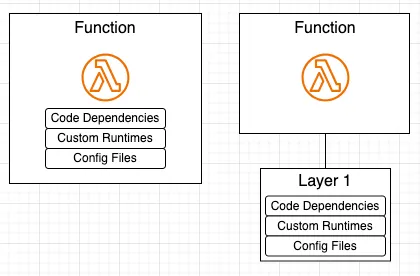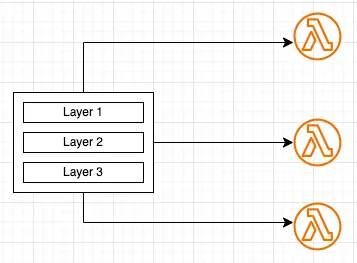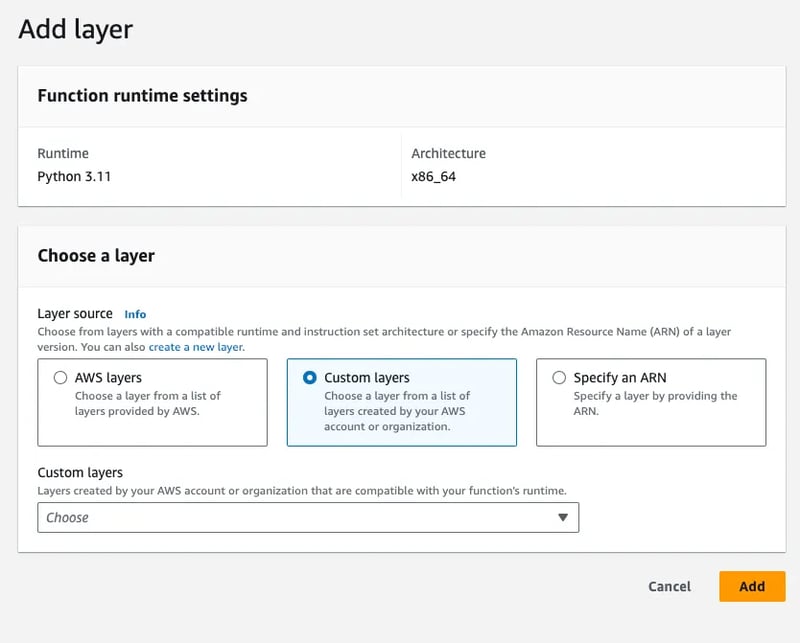Lambda Layers: The Secret Weapon of Savvy Serverless Developers

Kasun de Silva
Posted on March 15, 2024

When it comes to serverless development with AWS Lambda, keeping your code clean and efficient is essential. Lambda functions themselves have size limitations, and including all your dependencies within the function code can quickly bloat them. This is where Lambda layers come in — a powerful tool for streamlining your development process.
What are Lambda Layers?
Imagine a Lambda layer as a self-contained zip archive. This archive can hold various things, including:
- Library dependencies: Instead of bundling libraries with your function code, store them in a layer. This keeps your deployment packages leaner and easier to manage.
- Custom runtimes: Need a specific runtime environment for your function? Layers can provide that too.
- Configuration files: Separate your function’s core logic from configuration details by storing them in a layer.
Benefits of Using Lambda Layers
- Smaller Deployment Packages: By offloading dependencies to layers, you keep your function code concise and reduce deployment times.

Improved Code Maintainability: Separating function code from dependencies makes it easier to update and manage each independently.
Reusability: Layers can be attached to multiple functions, promoting code reuse and consistency across your serverless application.

- Standardized Runtimes: Manage custom runtimes through layers, continuing a consistent environment for your functions.
Simple Layer Example
Let’s say you have a Lambda function that needs to make API requests. You can create a layer containing the requests library. Here's a basic example:
-
Create a directory: Create a folder named
pythonfor your layer. -
Install the library: Inside the python directory, run
pip install requests -t. This installs therequestslibrary into the current directory. -
Zip the directory: Use the
zipcommand (or your OS's equivalent) to create a zip archive of the python directory. Name it something descriptive, likemy_requests_layer.zip.
Now you have a layer containing the requests library! You can upload this zip file to AWS Lambda and reference it in your function code.
Using the Layer in Your Lambda Function
Once you have uploaded your layer to AWS Lambda, follow these steps to use it in your Lambda function:
- Navigate to Lambda functions in the AWS console.
- Click on the “Layers” section from the left menu.
- Click “Create layer”, upload your zip file and hit “Create”.
Let’s Create a Lambda functions that using the requests library from a layer:
import json
import requests
def lambda_handler(event, context):
url = "https://api.example.com/data"
# Using the requests library from the layer
response = requests.get(url)
data = json.loads(response.text)
return {
"statusCode": 200,
"body": json.dumps(data)
}
- Create a new Lambda function using above code example.
- In the “code” tab scroll all the way to bottom and find the Layers section.
- Click on “Add Layer”
- Select “Custom layers” and chose the “python_requests” layer you just uploaded.
- Click “Add”
Then the custom layer you just created will be attached to your function.
In this example, the function imports requests without needing it installed within the function code itself. This keeps the deployment package lean and leverages the reusable layer.
Getting Started with AWS Lambda Layers
Using Lambda layers is straightforward. You create a zip archive containing your desired dependencies or configurations, upload it to AWS, and then reference it in your Lambda function code. Layers are versioned, so you can control exactly which version of the layer your function uses.
Here are some additional resources to get you started:
- AWS Lambda Layers Documentation: https://docs.aws.amazon.com/lambda/latest/dg/chapter-layers.html
- Using Lambda layers to simplify your development process: https://docs.aws.amazon.com/lambda/latest/dg/chapter-layers.html
Lambda layers are a valuable asset for any serverless developer on AWS. By leveraging layers, you can create cleaner, more manageable codebases, improve deployment efficiency, and promote code reuse across your serverless applications. So next time you’re building serverless functions with AWS Lambda, consider using layers to simplify your workflow and streamline your development process.

Posted on March 15, 2024
Join Our Newsletter. No Spam, Only the good stuff.
Sign up to receive the latest update from our blog.
Related

November 19, 2024






